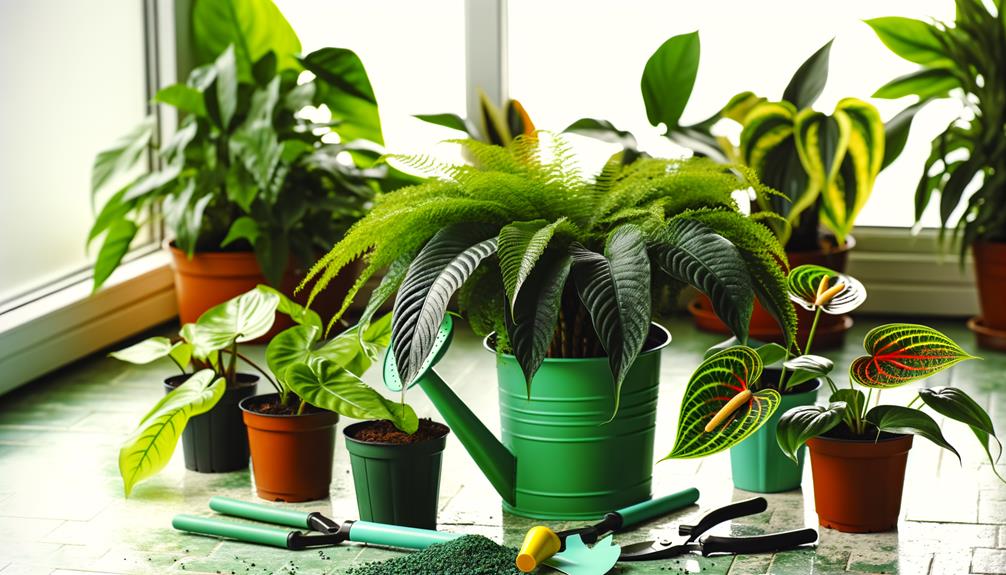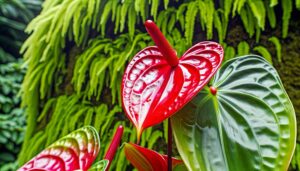Revive Your Queen Kimberly Fern Dieffenbachia and Anthurium With These 10 Tips
You can rejuvenate your Queen Kimberly Fern, Dieffenbachia, and Anthurium with these expert tips. Place plants near east or north-facing windows with sheer curtains to diffuse light.
Use a light meter and rotate weekly. Maintain humidity at 60-80% using humidifiers and group plants for microenvironments.
Water based on dryness: top inch for Kimberly Fern, top two inches for Dieffenbachia, and allow Anthurium soil to dry slightly between waterings. Use peat moss-rich soil with perlite for aeration, fertilize monthly, prune dead leaves with sterilized shears, and ensure proper drainage and airflow.
Each step enhances plant vitality, fostering robust growth.

Key Takeaways
- Position plants near east or north-facing windows with sheer curtains to ensure optimal light.
- Keep humidity levels between 60-80% using a hygrometer and humidifier.
- Water Queen Kimberly Fern when the top inch of soil is dry.
- Trim yellow or wilted leaves regularly with sterilized pruning shears.
- Use pots with multiple drainage holes and well-aerated soil to prevent root decay.
Assess Light Conditions
To properly assess light conditions for your Queen Kimberly Fern, Dieffenbachia, and Anthurium, make sure each plant receives the appropriate intensity and duration of indirect sunlight.
Position them near east or north-facing windows, ensuring they get bright, filtered light without direct sun exposure. Utilize sheer curtains if needed to diffuse harsh rays.
Monitor the leaf color and growth patterns; pale, yellowing leaves indicate excessive light, while leggy growth suggests insufficient illumination. Use a light meter if precision is desired, aiming for 200-500 foot-candles.
Rotate the plants weekly to maintain symmetrical growth. By fine-tuning the light conditions, you'll provide an environment where your plants can thrive, giving you the freedom to enjoy their lush beauty without constant worry.
Optimize Watering Schedule
Maintaining a perfect watering schedule for your Queen Kimberly Fern, Dieffenbachia, and Anthurium involves understanding each plant's specific moisture needs and adjusting your routine accordingly.
For the Queen Kimberly Fern, make sure the soil remains consistently moist but not waterlogged; water thoroughly when the top inch feels dry.
Dieffenbachia prefers evenly moist soil; water when the top two inches dry out, and guarantee good drainage to prevent root rot.
Anthuriums thrive when watered deeply but infrequently; let the top 1-2 inches of soil dry out before the next watering. Use room-temperature, dechlorinated water to avoid shock.
Adjust frequency based on seasonal changes and humidity levels, ensuring your plants receive adequate hydration without excess.
Your plants will flourish with precision and care.
Improve Soil Quality
Enhancing soil quality for your Queen Kimberly Fern, Dieffenbachia, and Anthurium involves selecting the right mix, guaranteeing proper aeration, and incorporating organic matter. Choose a soil blend rich in peat moss, perlite, and compost to balance moisture retention and drainage. Aeration is vital; use a soil probe or gently till the soil to prevent compaction.
| Essential Component | Purpose |
|---|---|
| Peat Moss | Retains moisture |
| Perlite | Enhances drainage |
| Compost | Provides nutrients |
| Soil Probe | Improves aeration |
| Organic Fertilizer | Boosts soil health |
Integrate organic fertilizer monthly to enrich the soil with essential nutrients. This meticulous approach guarantees your plants' root systems thrive, promoting lush and vibrant growth.
Prune Dead Foliage
Pruning dead foliage is vital for preventing disease and encouraging new growth in your Queen Kimberly Fern, Dieffenbachia, and Anthurium.
First, sterilize your pruning shears with rubbing alcohol to avoid transferring pathogens. Carefully examine your plants, identifying any yellowed, browned, or wilted leaves.
For the Queen Kimberly Fern, trim fronds at the base, close to the soil. With Dieffenbachia, cut the leaf stems about an inch above the main stem. For Anthuriums, snip off dead leaves at their base, ensuring not to damage healthy tissue.
Regular pruning not only maintains plant health but also diverts energy to vibrant, new growth. Remember, clean cuts are essential—jagged edges invite pests and diseases, which you surely want to avoid.
Control Humidity Levels
To guarantee maximum growth for your Queen Kimberly Fern, Dieffenbachia, and Anthurium, you must meticulously control the humidity levels within their environment. Aim for humidity levels between 60-80%. Use a hygrometer to monitor this precisely.
If levels drop, employ a humidifier or place plants on humidity trays filled with water and pebbles. Grouping plants can also create microenvironments that retain moisture. Mist leaves regularly but avoid over-wetting, as this can lead to fungal issues.
Maintain proper air circulation to prevent mold. During winter months, keep plants away from heating vents, which dry the air. By maintaining ideal humidity, you promote robust plant health and vibrant growth, allowing you the freedom to enjoy lush, thriving greenery.
Fertilize Appropriately
To maximize the health of your Queen Kimberly Fern, Dieffenbachia, and Anthurium thrive, you'll need to choose a balanced N-P-K ratio fertilizer.
Apply this fertilizer according to a seasonal feeding schedule, providing nutrients more frequently during their active growing months.
Always follow specific dilution instructions to prevent root burn and nutrient overload.
Optimal Fertilizer Choice
Choosing the correct fertilizer is crucial for maintaining the health and vibrancy of your Queen Kimberly Fern, Dieffenbachia, and Anthurium, as each plant has specific nutrient requirements for optimal growth.
For Queen Kimberly Fern, choose a balanced 20-20-20 liquid fertilizer, diluted to half strength.
Dieffenbachia thrives with a 20-20-20 or 10-10-10 liquid fertilizer, applied monthly at half strength.
Anthurium benefits from a high-phosphorus fertilizer, such as 10-30-20, to promote flowering.
Always opt for water-soluble types for even nutrient distribution. Avoid over-fertilizing, which can lead to nutrient burn. Make sure you're using fertilizers free of urea, which can harm roots.
Seasonal Feeding Schedule
Understanding the seasonal feeding schedule for your Queen Kimberly Fern, Dieffenbachia, and Anthurium guarantees they receive the right nutrients at the right time, promoting robust growth and vibrant blooms.
For best results, adjust your fertilizing approach throughout the year:
- Spring and Summer: Fertilize every two weeks with a balanced, water-soluble fertilizer. These months are peak growing periods, and your plants need more nutrients.
- Fall: Reduce feeding to once a month. Growth slows down, so they require fewer nutrients.
- Winter: Suspend fertilization. During dormancy, plants aren't actively growing, and excess nutrients can harm them.
Precisely timing your fertilization schedule ensures your plants thrive without overfeeding, maintaining their health and vigor all year round.
Monitor for Pests
Regularly check the foliage and soil of your Queen Kimberly Fern, Dieffenbachia, and Anthurium for signs of common pests such as spider mites, aphids, and mealybugs. Examine the undersides of leaves and stems where these insects often hide. Use a magnifying glass for a thorough check.
If you notice sticky residue, webbing, or discolored spots, it's time for action. Introduce beneficial insects like ladybugs or apply neem oil to affected areas. Make sure you maintain proper humidity levels, as dry conditions can worsen pest problems.
Quarantine new plants before integrating them with your existing collection to prevent infestations. By staying vigilant and using integrated pest management techniques, you'll keep your plants healthy and thriving without compromising your freedom.
Ensure Proper Drainage
To guarantee adequate drainage, you must select a pot with multiple drainage holes to allow excess water to escape.
Use a well-draining soil mix to prevent water accumulation around the roots, which can cause rot.
Regularly check the saucer under the pot and empty any standing water to maintain ideal conditions.
Choose Suitable Pot
Selecting a pot with sufficient drainage holes is crucial to prevent waterlogging and root rot in your Queen Kimberly Fern, Dieffenbachia, and Anthurium.
Opt for pots made from porous materials like terracotta or ceramic, which allow better airflow and moisture evaporation. Make sure the pot has multiple drainage holes to facilitate proper water flow.
When choosing a pot, consider:
- Size: Choose a pot that's 1-2 inches larger in diameter than the root ball to allow growth but avoid overly large pots that hold excess moisture.
- Material: Select breathable materials that help regulate soil moisture.
- Depth: Confirm the pot's depth accommodates root systems while promoting effective drainage.
These considerations will help maintain the ideal growing environment for your plants.
Avoid Water Accumulation
Promoting proper drainage is crucial to prevent water buildup that can result in root decay in your Queen Kimberly Fern, Dieffenbachia, and Anthurium.
Start by choosing pots with multiple drainage holes to facilitate excess water drainage. Use a well-aerated soil mix—incorporate perlite or orchid bark for ideal aeration. Raise pots slightly using pot feet or a plant stand to improve airflow underneath.
Regularly inspect saucers and remove stagnant water to prevent saturation. Establish a watering schedule tailored to each plant's specific moisture requirements, avoiding excessive watering. For indoor plants, consider using a moisture meter to accurately measure soil moisture levels.
Following these steps guarantees that your plants' roots remain healthy and unfettered from harmful water accumulation.
Repot When Necessary
Repotting your Queen Kimberly Fern, Dieffenbachia, and Anthurium is essential when you notice roots emerging from drainage holes or the soil drying out excessively fast. Begin by selecting a pot that's 1-2 inches larger in diameter than the current one.
Gently remove the plant, taking care not to damage the roots, and shake off old soil. Place the plant in the new pot, ensuring it's centered, and fill with a well-draining potting mix.
Use fresh, high-quality potting soil to provide essential nutrients.
Water thoroughly after repotting to settle the soil and eliminate air pockets.
Monitor for root-bound signs every 12-18 months to determine future repotting needs.
These steps will help your plants thrive in their new environment.
Provide Adequate Airflow
Maintaining appropriate airflow around your Queen Kimberly Fern, Dieffenbachia, and Anthurium is crucial to prevent fungal infections and promote healthy growth. Start by positioning your plants in a well-ventilated area. Avoid overcrowding; make sure each plant has ample space to breathe.
Use oscillating fans to circulate air, making sure they're not blowing directly onto the plants, which can cause desiccation. Regularly prune any dead or yellowing leaves that can obstruct airflow.
For indoor environments, consider opening windows periodically to introduce fresh air. If using grow tents, install ventilation systems equipped with intake and exhaust fans.
Conclusion
By following these expert tips, you'll breathe new life into your Queen Kimberly fern, Dieffenbachia, and Anthurium.
Think of your plants as delicate instruments in an orchestra—each element like light, water, and soil plays an essential note in their symphony of health.
Regularly assess and adjust their care to make sure they thrive.
With diligence and attention, your indoor garden will flourish, transforming your space into a lush, verdant sanctuary.






